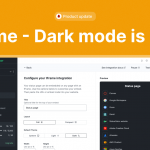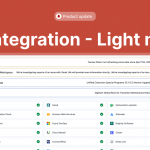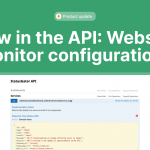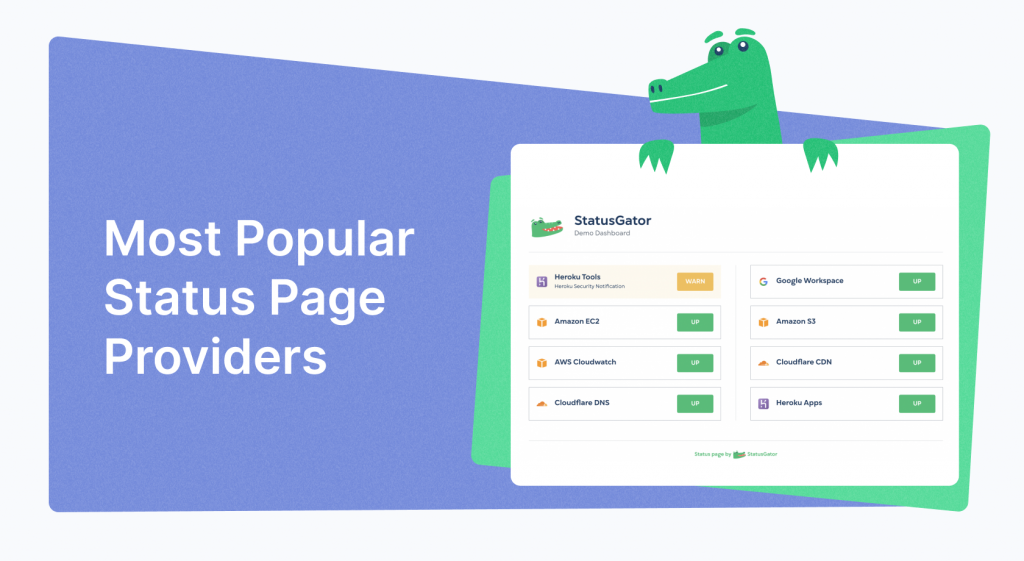
Updated on April 26, 2024
For SaaS companies and cloud vendors, a status page isn’t just a tool — it’s a testament to their commitment to users. But with numerous status page providers in the market, which ones are the top SaaS companies gravitating towards?
It comes as no surprise that the most popular status page provider in 2024 is Statuspage.io offered by Atlassian. We expected it at StatusGator when we began our analysis. However, our curiosity didn’t stop there. We looked further to uncover the other prominent providers.
So, let’s find out what are the 15 most popular status page providers in 2024.
The Data Behind This Study
To answer this question objectively, we took an analytical approach.
Using the data from our own product, StatusGator, we examined the status pages of the top 2,836 SaaS companies and cloud vendors, including notable names like Zoom, Cloudflare, Slack, GitHub, and Azure.
Our analysis aimed to identify which providers these companies used for their own status pages.
We then organized this information into a spreadsheet to showcase the popularity of each status page provider in 2024.
15 Most Popular Status Page Services
Here’s the result of our study based on the analysis of 2,836 SaaS companies and cloud vendors that operate in different niches.
| Status page providers | SaaS and cloud vendors |
|---|---|
| Statuspage | 2,164 |
| Status.io | 107 |
| Sorry | 103 |
| UptimeRobot | 94 |
| Instatus | 90 |
| Better Uptime | 46 |
| Hund | 37 |
| Pingdom | 35 |
| Cachet | 33 |
| Statuspal | 24 |
| Freshstatus | 23 |
| StatusHub | 23 |
| Uptime | 20 |
| StatusCast | 19 |
| Crisp | 18 |
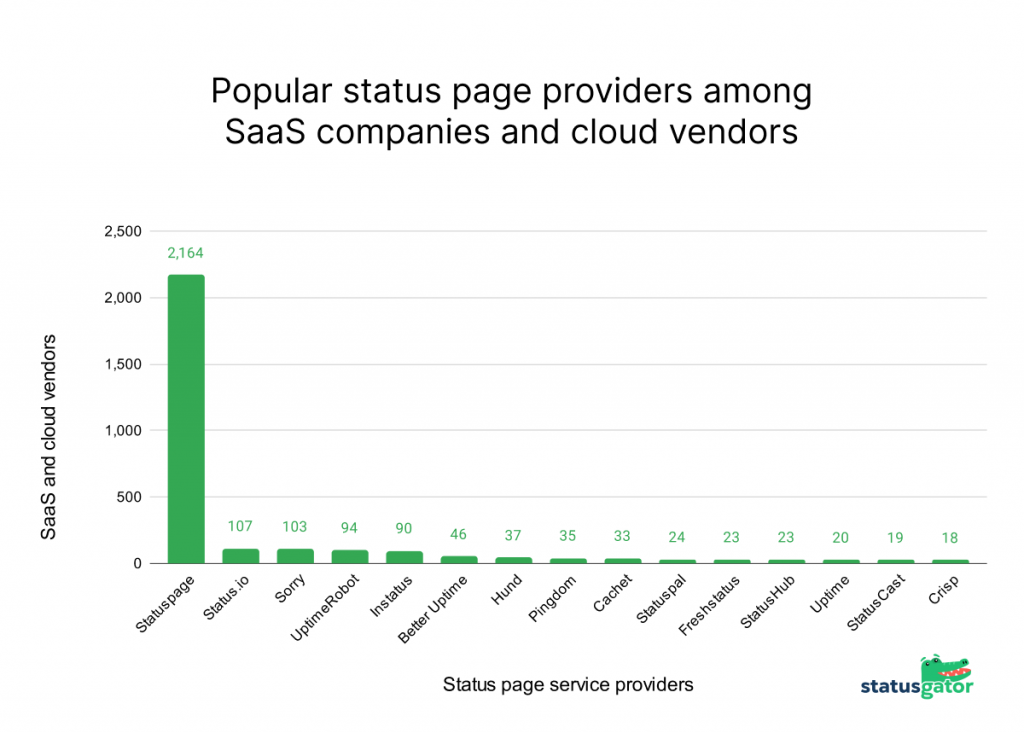
As we can see, Atlassian Statuspage.io is the most popular status page provider in 2024. However, our data reveals the next 14 popular providers, as well as how many SaaS companies and cloud vendors use their services. Knowing this, we can break down each provider to see what they offer.
But before we get down to the list, there’s a useful tool for any SaaS company that we need to mention.
StatusGator — An All-in-One Private Status Page Solution
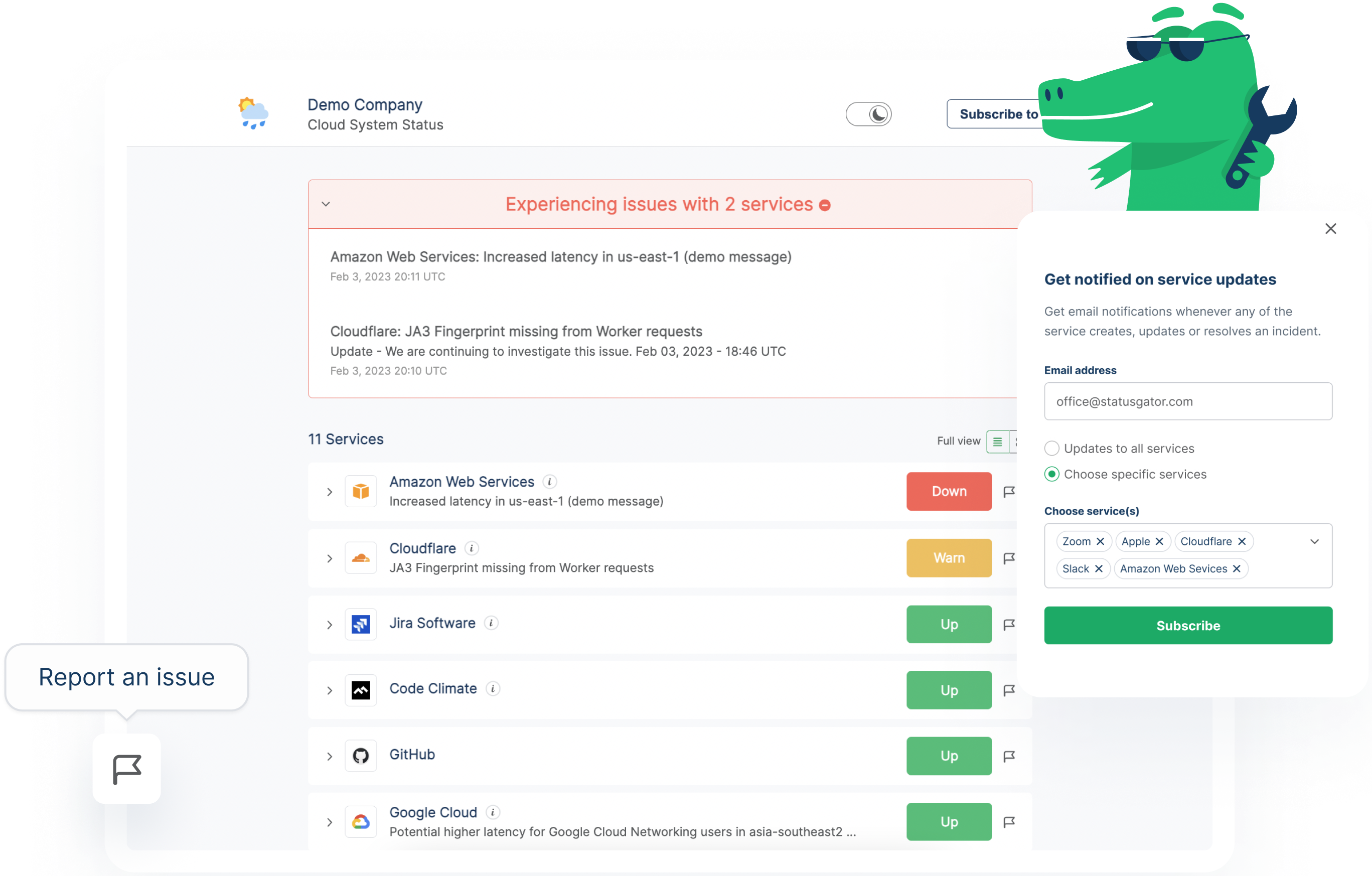
StatusGator monitors thousands of cloud vendors, hosted applications, websites, and third-party services, along with all your internal websites and applications, and aggregates their statuses into an all-in-one status page.
Effectively communicating the status of services and dependencies, StatusGator caters to IT teams, DevOps, MSPs, helpdesk, K-12, colleges, and universities.
StatusGator offers private status pages, audience-specific status pages, and public status pages. For more detailed monitoring, users can choose specific services to monitor, like EC2 by AWS, Codespaces by GitHub, or specific regions, like us-east-1 AWS Region.

A free trial is available on all plans, and a free plan is available too.
Clients: PagerDuty, Stack Overflow, Blackbaud, and others use private status pages and outage notification services by StatusGator.
1. Statuspage
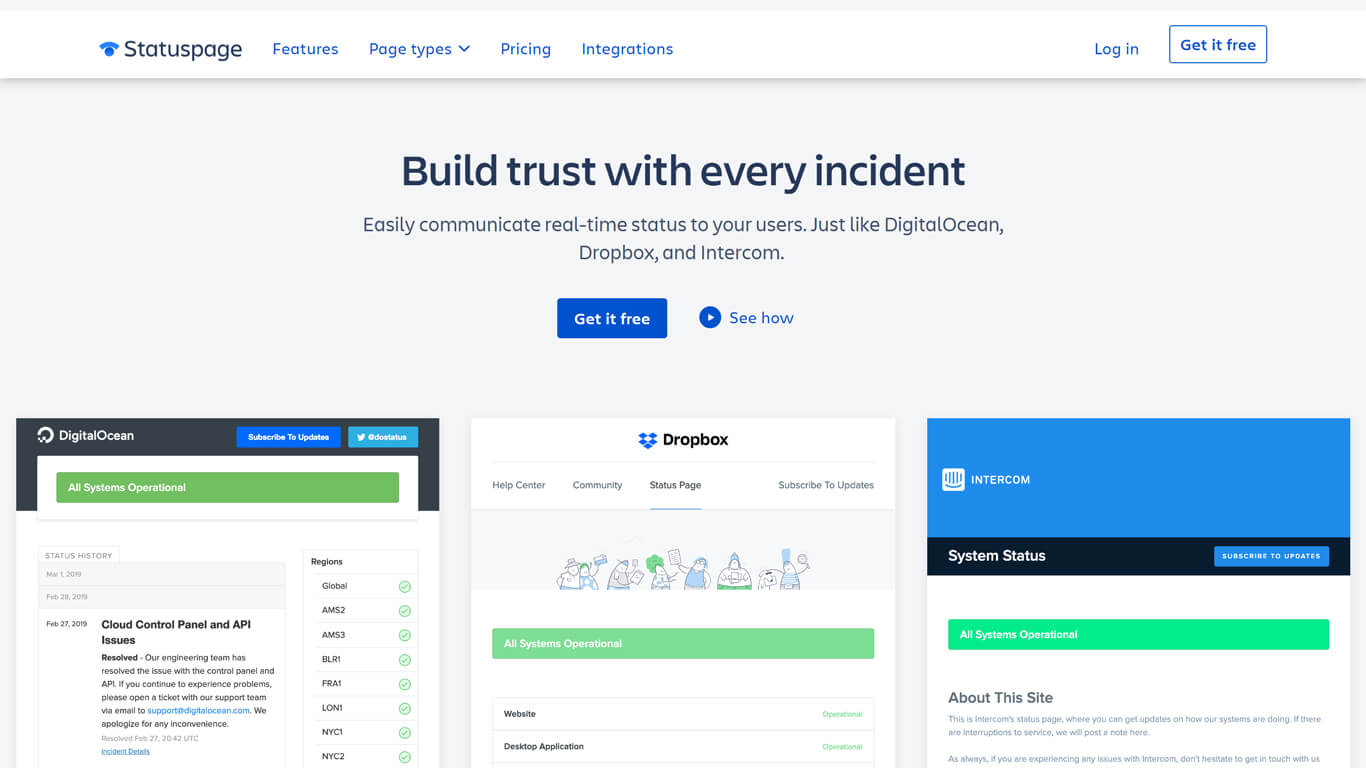
Statuspage.io is a leading incident communication platform designed to keep users informed about the operational health of digital services.
Users can create a customized status page that displays real-time statuses and status updates for all the services they rely on, including third-party services. Users can showcase reliability with previous uptime history, access API, and integrate with numerous tools.
Public, private, and audience-specific status pages are available but billed separately. Users can select a plan depending on their business or service, ranging from $29 per month to $1,499 per month. There is a free plan available too for a public status page.
Clients: Reddit, Squarespace, Twilio, Twitter, Litmus.
2. Status.io
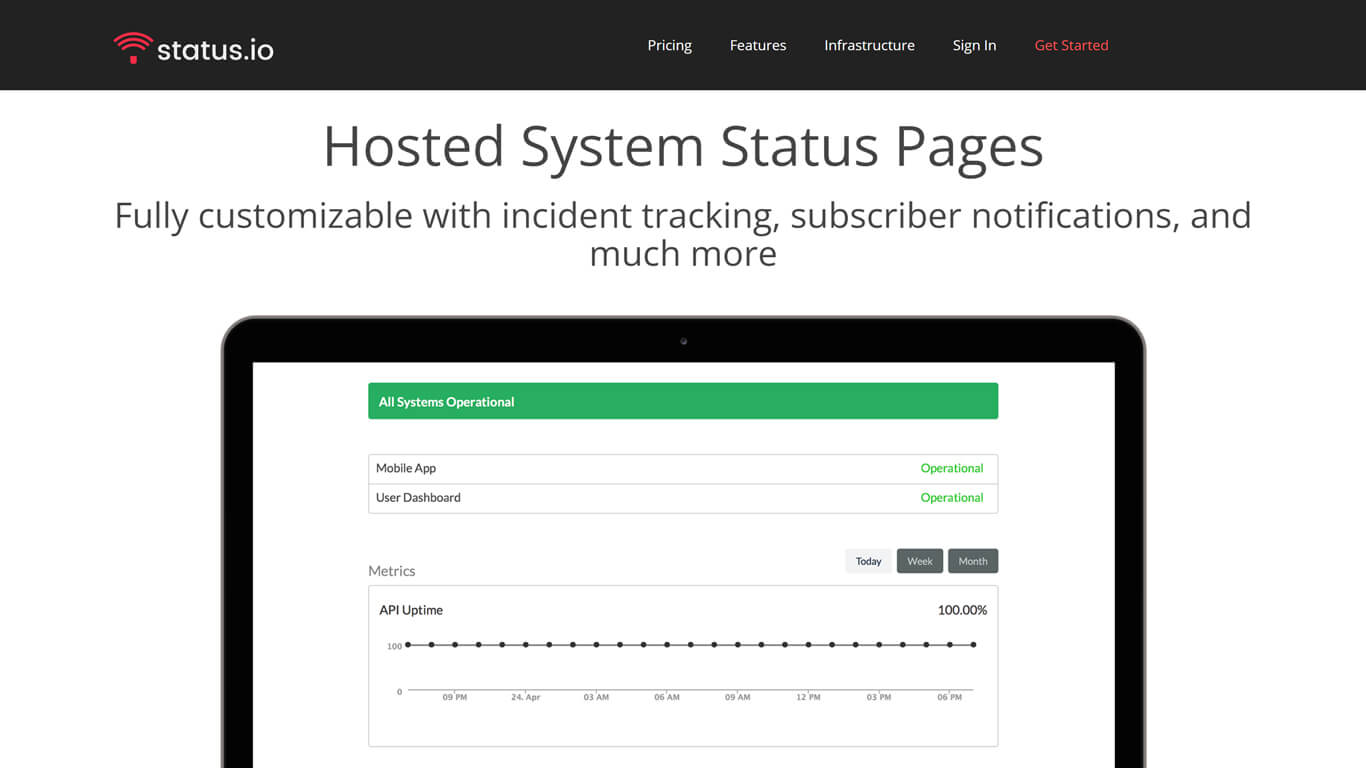
A key feature of Status.io is their global infrastructure. It ensures that your status page is always available, even if there’s a major internet outage in any part of the world.
The platform also prioritizes security. From SSL encryption to DDoS protection, Status.io ensures that your data and your status page remain secure from threats. Other functions include API access for developers (including public status), displaying uptime metrics, and offering various third-party integrations such as Librato, New Relic, and Twitter.
Additionally, Status.io offers a simple and customizable dashboard that allows businesses to manage and display the status of their services. They have 3 plans, Basic, Standard, and Plus plans, but no free version. Private status pages are available on their Plus plan starting at $349 per month.
Clients: Docker, Yahoo, Let’s Encrypt.
3. UptimeRobot
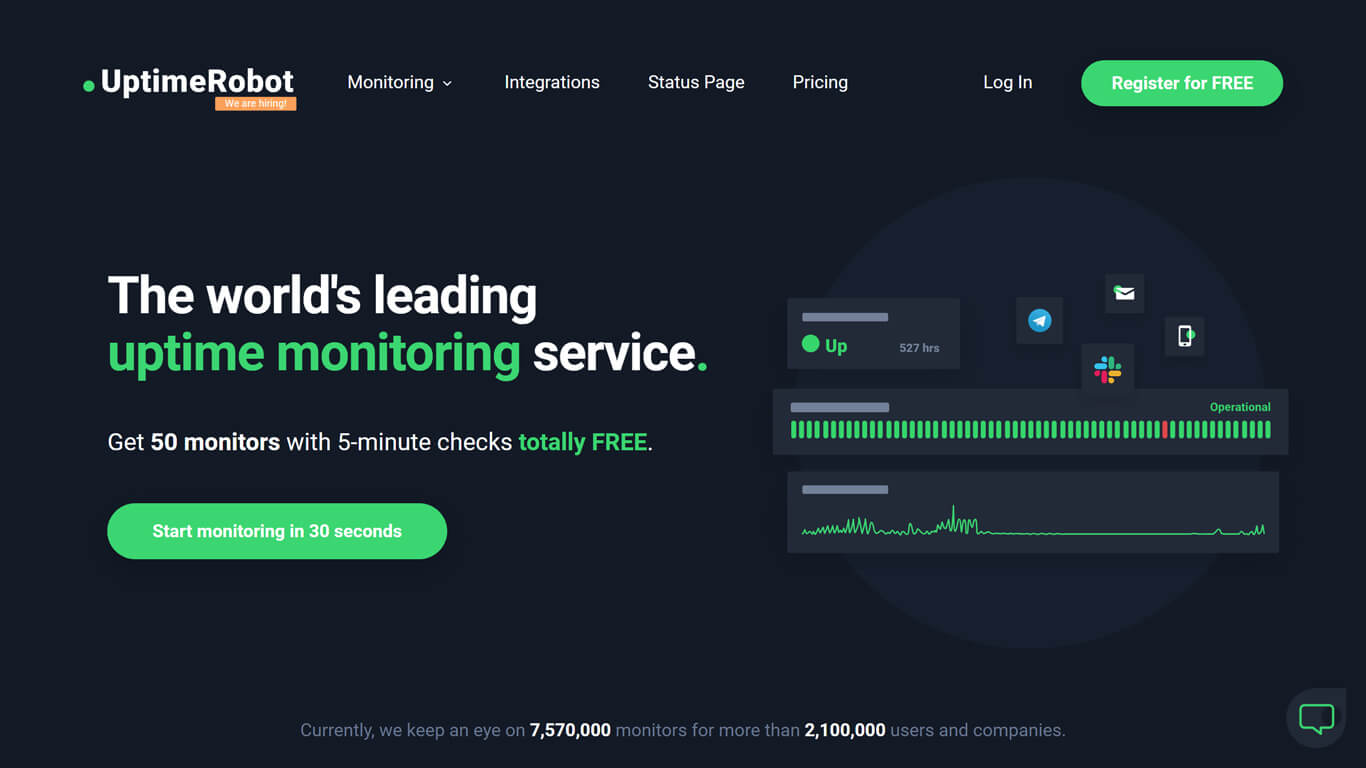
UptimeRobot is a monitoring service that offers a range of features to help users keep track of their websites, domain expiration, SSL, cron job, and other systems.
Secondary to their monitoring services, they offer private status pages, subscriber notifications, analytics, and a status page on a custom domain.
With this status page provider, users can choose to hide or show a range of status page metrics, uptime percentage monitored URLs, and so on. If some monitors are paused, users can also hide them from the status page.
UptimeRobot has a range of customization options so users can tailor status pages to their brand, by changing themes, logos, fonts, colors, and more.
Clients: GoDaddy, NASA, Expedia.
4. Instatus
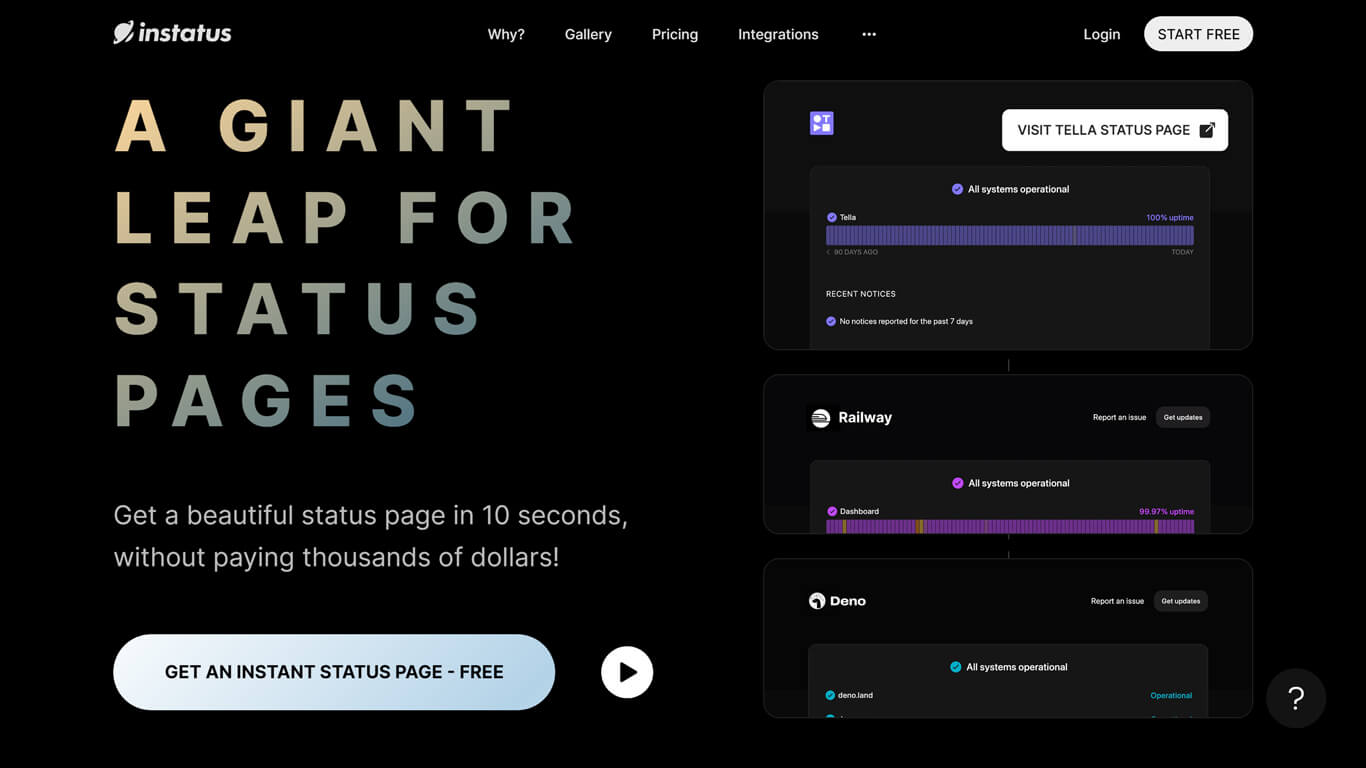
Instatus markets as low-cost status pages. As stated on their website, you can ‘get a beautiful status page in 10 seconds, without paying thousands of dollars!’. Their services are priced at just 5% of Statuspage’s monthly fee.
Instatus offers a free status page. Users are encouraged to try Instatus for free and upgrade if they want a custom domain for their status page for $20 per month or add a private status page for $50 per month.
Teammates or collaborators can update status pages without additional costs. Instatus, unlike other popular status page providers on the list, features unlimited subscribers to the status page notifications.
Instatus services for businesses cost $300 per month and include sign-in via SSO or SAML, three status pages, and whitelisting access to the status page based on email or IP address.
Clients: Deno, Podium, Wistia.
5. Sorry
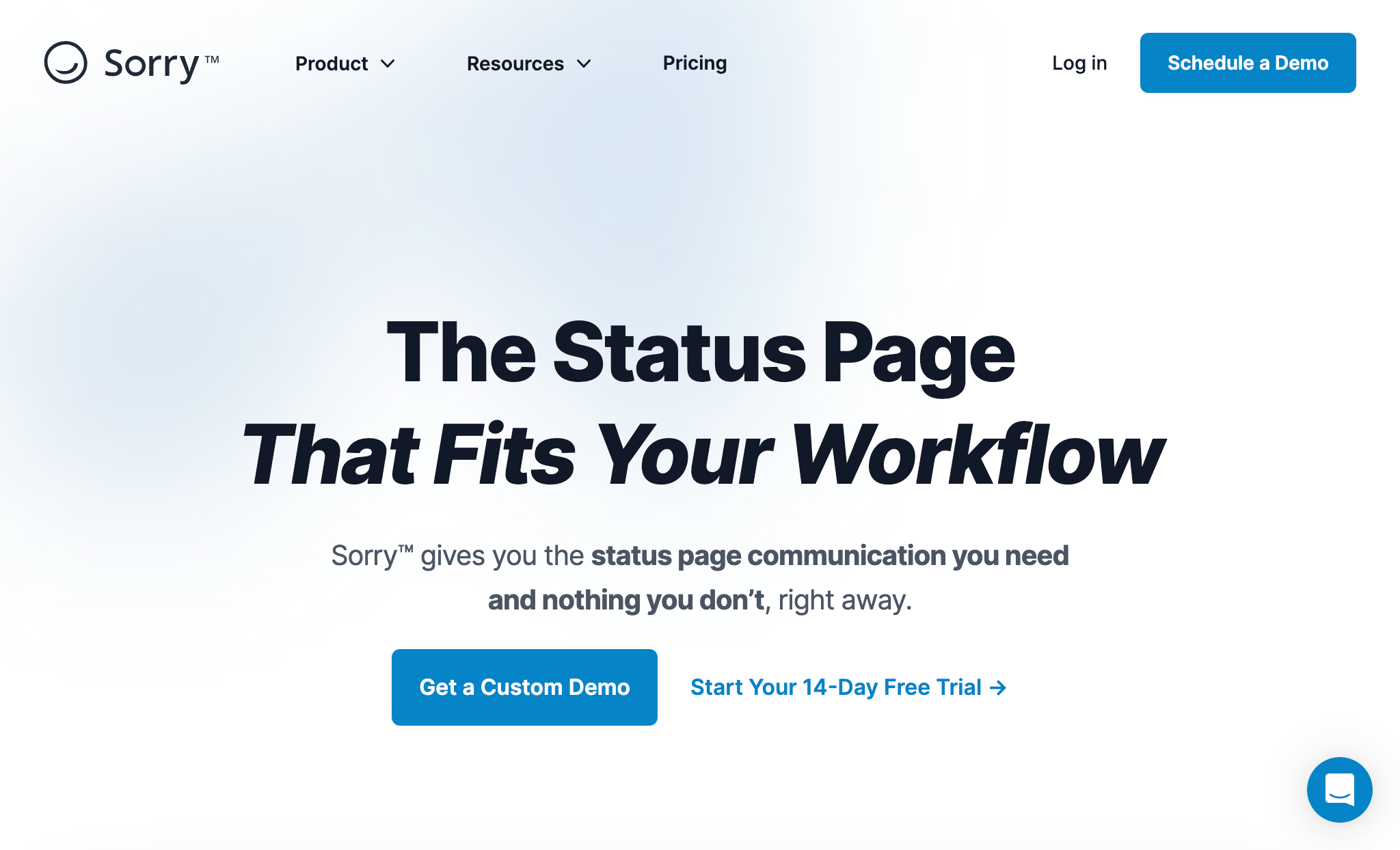
Sorry is an app offering easy-to-read status pages that provide information on incidents and the history of outages.
This status page provider integrates seamlessly with popular communication tools, including Slack, Microsoft Teams, and Intercom.
Sorry App also offers status page translations into 20 languages.
Easy-to-use customization tools allow users to personalize their status pages and 500 error pages.
Additional features include built-in SSL certification, a status plugin for your website, automated subscriber notifications, and integrated links to your support channels.
Clients: Pingdom, NHS, Postmark, Replit.
6. Hund
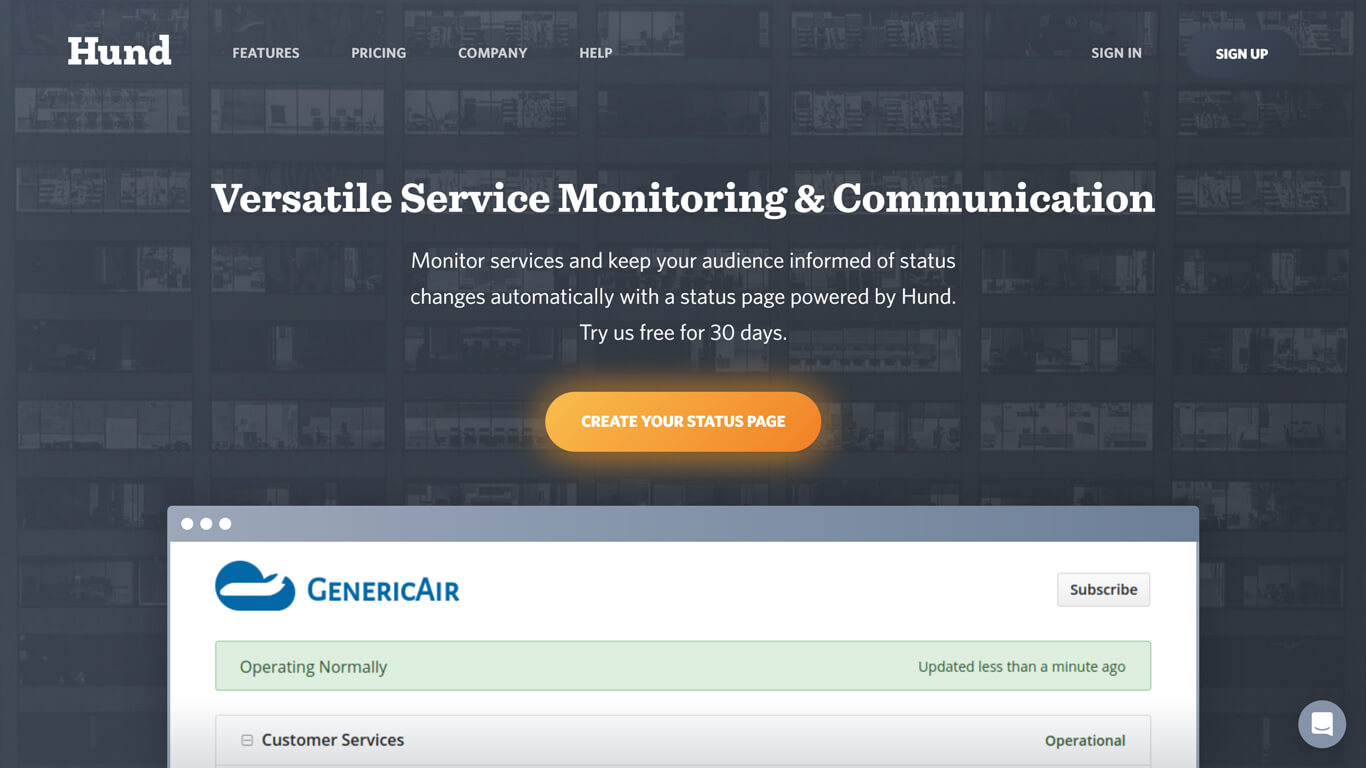
One of Hund’s main attributes is that it has a unique monitoring infrastructure. They track various services, including ICMP-enabled servers, HTTP/S endpoints, TCP/UDP ports, and DNS queries. Furthermore, they offer integration with third-party monitoring solutions. This includes AWS CloudWatch, PagerDuty, Pingdom, and New Relic.
One other unique feature of Hund’s status page is the ability to manage subscribers by adding, deleting, and modifying them. You can also control what notifications they receive.
This popular status page service also implements disaster recovery protocols to reduce potential downtime, maintaining transparency throughout via displaying uptime performance.
Clients: MacEwan University, Oak by Stanford, LineageOS, Digimind, Elavon.
7. Pingdom
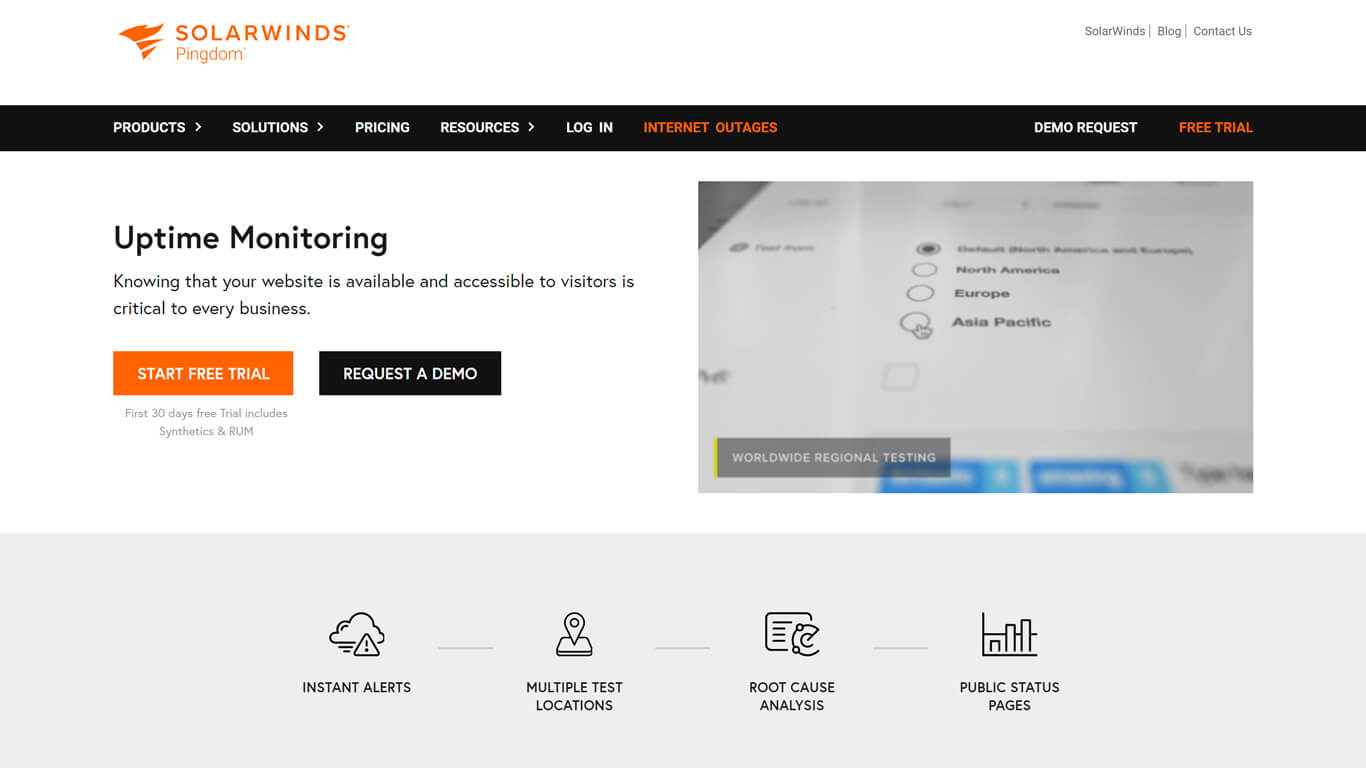
Pingdom offers external status pages for your website with various analytic and metric tools. Status pages can be personalized and tailored to your brand, with the ability to select which metrics are on display. Admins can display current status or choose to import previous uptime history should they wish.
Pingdom’s public status pages are designed to track and display adherence to service level agreements (SLA). This offers your clients external validation to reassure them that you’re meeting your SLAs, increasing transparency.
Pingdom’s status page can also integrate with a variety of apps such as Slack, OpsGenie, PagerDuty, and more. A 30-day free trial is available, with the option to request a demo included.
Clients: Imgur, Evernote, Trust Radius.
8. Cachet
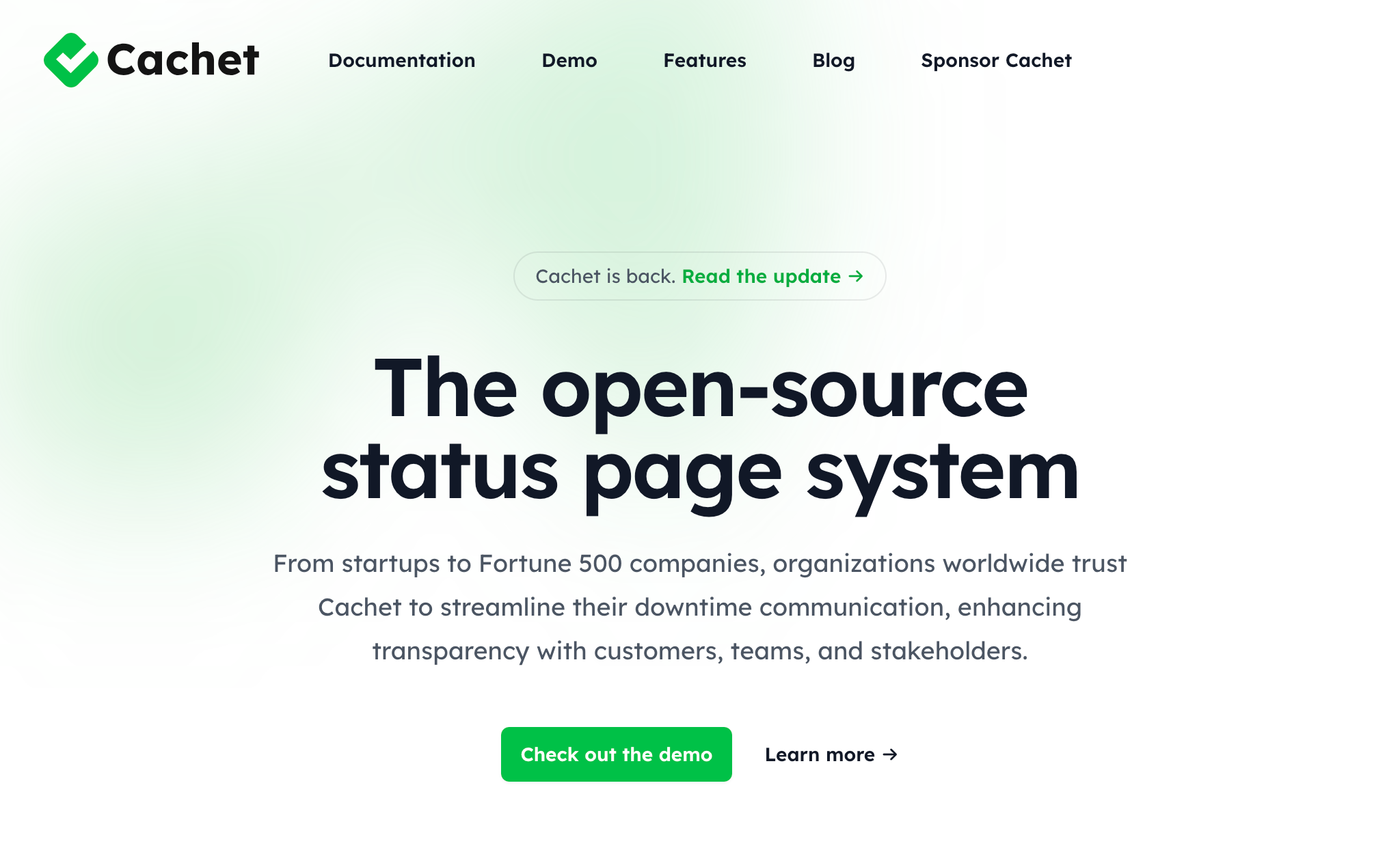
With Cachet, users get a variety of options to customize their status page. It’s an open-source status page system for businesses of all sizes. Cachet emphasizes transparency regarding system status, especially during downtime or maintenance activities.
Cachet uses JSON API for automation, aiming to simplify the process of updating your status page with status reports and changes. Additionally, Cachet offers a comprehensive dashboard for tracking various metrics. This includes uptime, error rates, and custom indicators to enhance transparency among users. This popular provider supports over 10 languages.
Businesses have the option to sponsor the project on GitHub if they wish. Cachet also assists users in ensuring a smooth setup process for $249.
Clients: Bosch, Sky, European Environment Agency.
9. Better Uptime
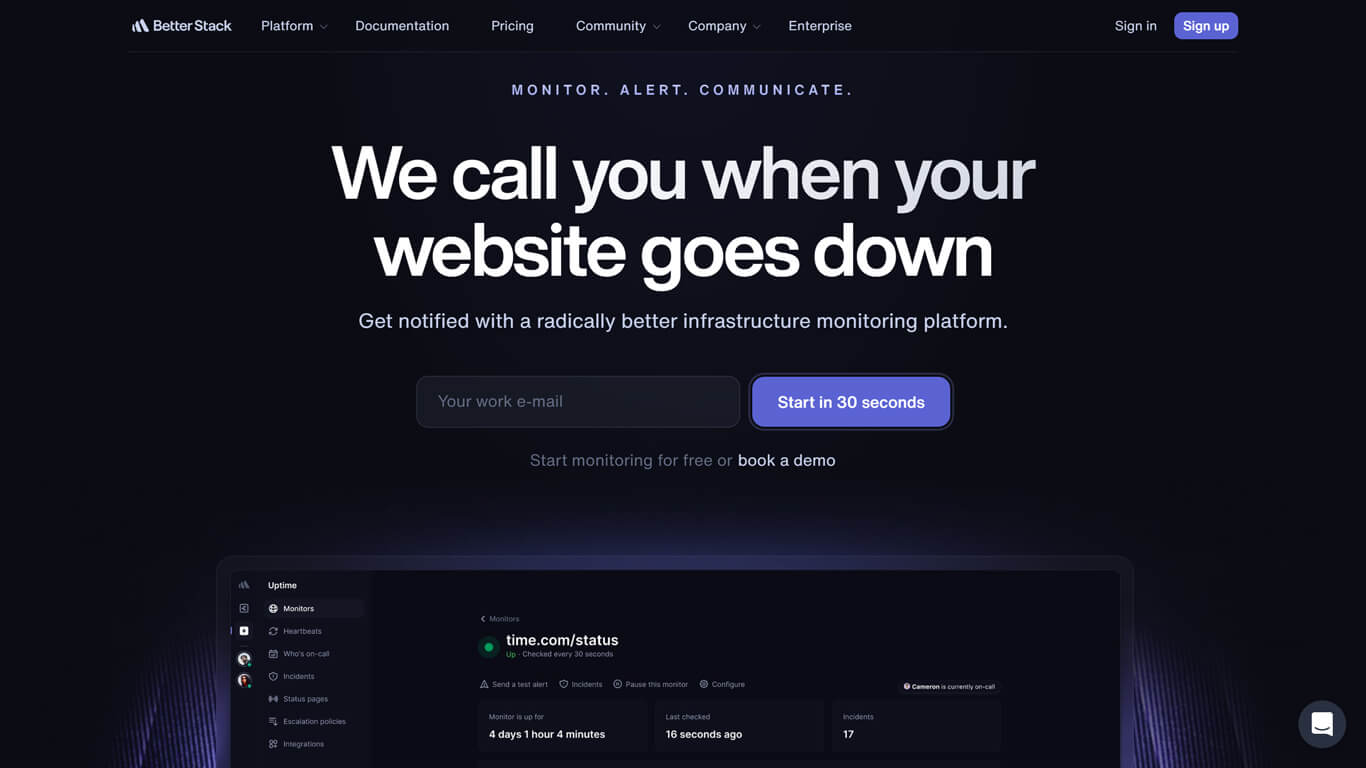
BetterStack’s Uptime solution, formerly known as Better Uptime, is an infrastructure monitoring platform. Their primary service includes log and incident management with uptime monitoring. Service performs checks every 30 seconds. Whenever an incident occurs, Uptime by BetterStack sends a screenshot of the error and a detailed timeline.
They also offer a status page that can be customized and hosted on a custom domain. Status page subscribers receive email alerts of any changes to the status of the app or service.
With a free plan from this status page provider, users get 5 status pages and 10 monitors. Keep in mind that you can find the status page on their Uptime service pricing page.
Clients: Raspberry Pi, Octopus Deploy, Raycast.
10. Statuspal

With its centralized status dashboard, Statuspal lets you easily share real-time updates with your team and customers. Statuspal also allows you to proactively communicate incidents and maintenance automatically. Plus, it comes with built-in monitoring.
On top of that, Statuspal lets you showcase your application’s historical SLAs and uptime metrics. Statuspal tracks and notifies you about any real-time issues with these services. Various design tools are included, from domain customization to style changes, to help you customize your status page.
With a user-friendly interface for incident reporting and multi-language support, Statuspal is designed to be user-friendly. They also offer private status pages. Paid plans are available, but they offer a 14-day free trial too.
Clients: ChartMogul, Decathlon, Roche.
11. Freshstatus
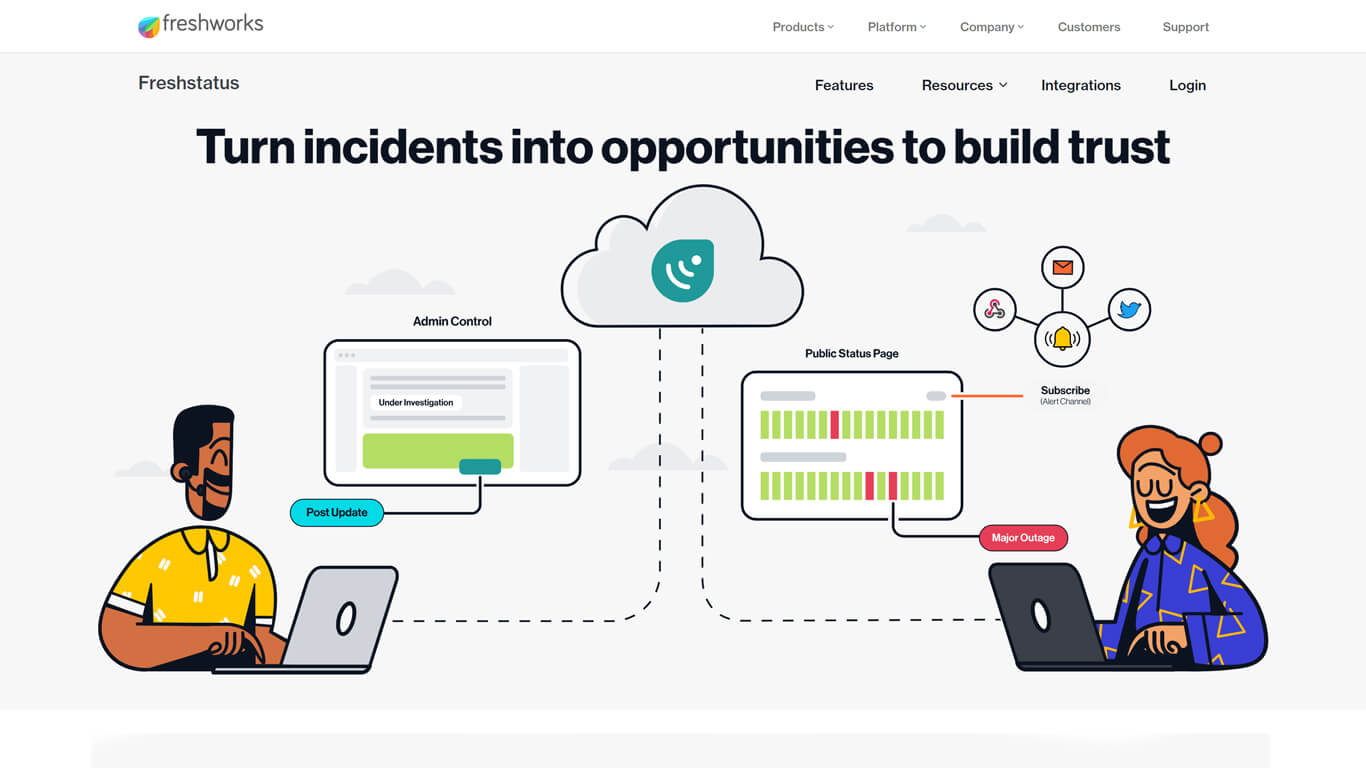
Users, including subscribers and employees, receive incident updates through various channels, aided by incident templates for swift issue reporting. The platform seamlessly integrates with tools like Freshping, Freshdesk, Slack, and more, This provides flexibility to ensure users receive notifications via their preferred channel.
Freshstatus also emphasizes customization, offering options for tailoring the status page’s appearance, This includes custom domains, brand colors, and social media links. Additionally, it provides customizable alert emails.
Clients: Etherscan, Delmar, All Saints College.
12. StatusHub
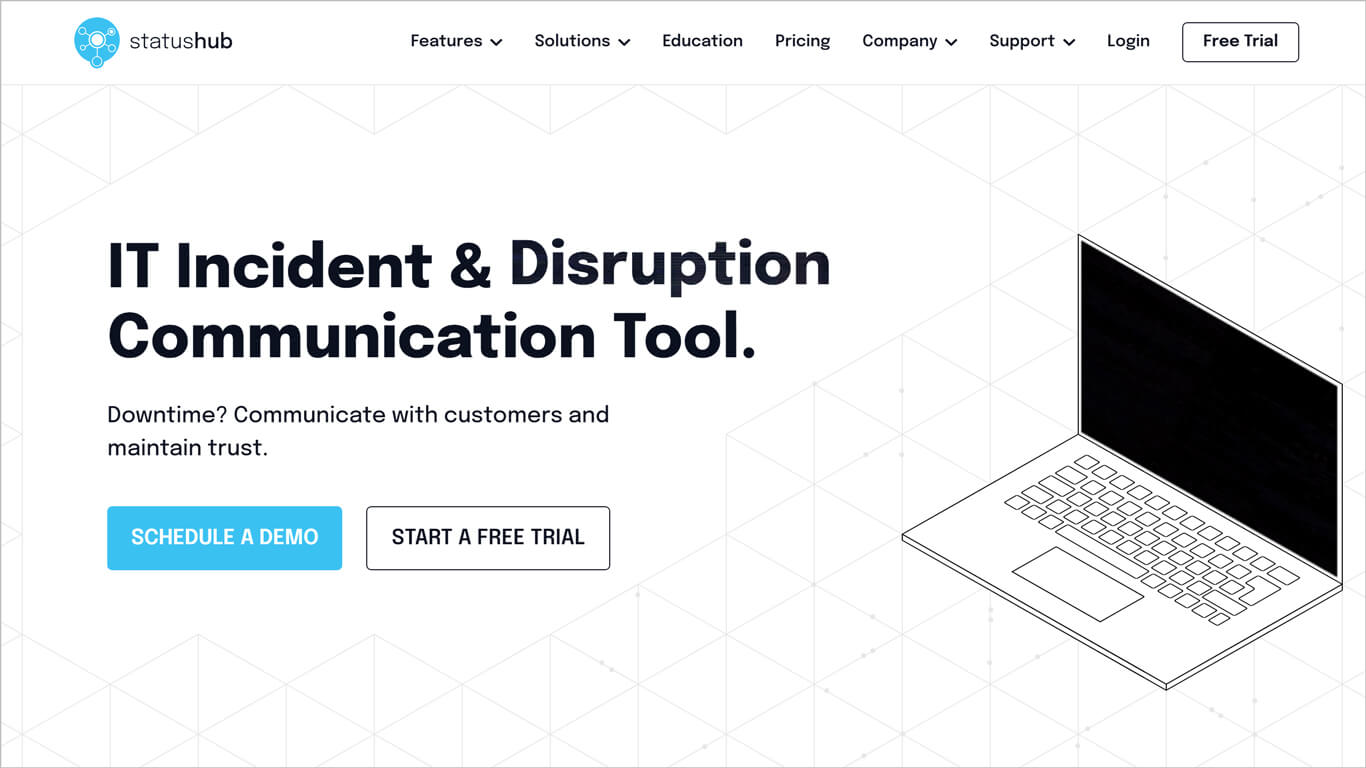
StatusHub is an IT incident communication tool designed to keep customers and teams informed during any downtime. Users can create both public and private status pages, securing them with SAML 2.0 and OAuth for authorized access. Even when servers are down, hosted status pages remain accessible, ensuring continuous communication.
Multiple status pages can be operated through the connected hubs, optimizing incident management. It seamlessly integrates with monitoring tools for automated incident reporting or manual incident creation and can integrate with various tools for incident communication. A demo is available, as is a free trial.
Clients: Bottomline Technologies, Texas State University, Datavita.
13. Uptime

They offer public status pages to communicate service status. This includes real-time downtime alerts via email, SMS, and phone, and a maintenance windows feature for planned maintenance. Users can benefit from comprehensive domain monitoring at one-minute intervals from global locations.
The platform provides reporting features for performance analysis and a customizable dashboard. Some features include metric summaries, checks, and alerts. These tools make Uptime.com a fast-acting, responsive status page provider.
Uptime.com is also integration-friendly and offers a 30-day money-back guarantee for its services.
Clients: KraftHeinz, LUXOTTICA, razorfish.
14. Statuscast
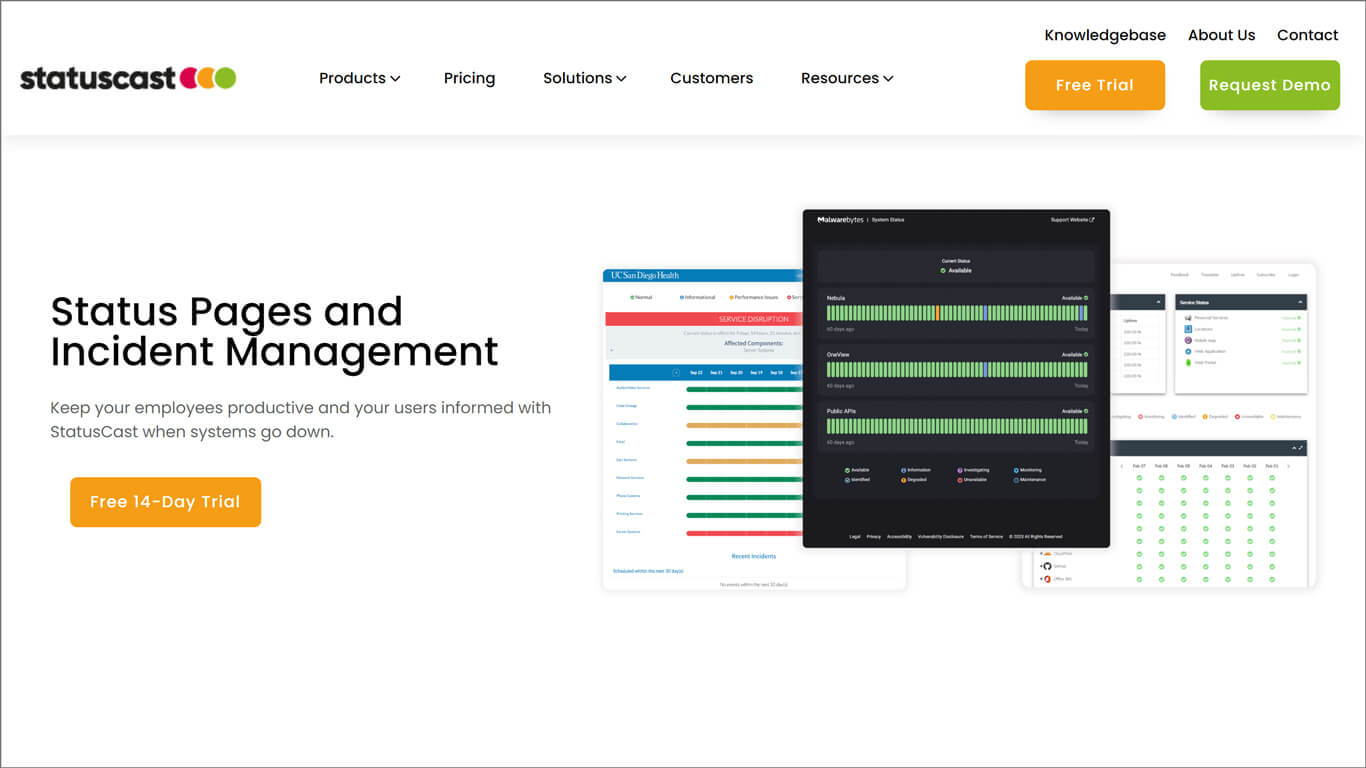
Statuscast offers users public, private, and audience-specific status pages. Some notable features are uptime reporting, role-based widgets, and access control. Furthermore, Statuscast allows users to integrate with third-party services code-free.
Alongside these features, they combine incident collaboration. They combine features such as incident reporting, forensic examination, and problem identification. They emphasize their on-call management service, as well as their collaboration tools and the ability to display historical data.
Statuscast offers a free trial before subscribing to a paid plan.
15. Crisp
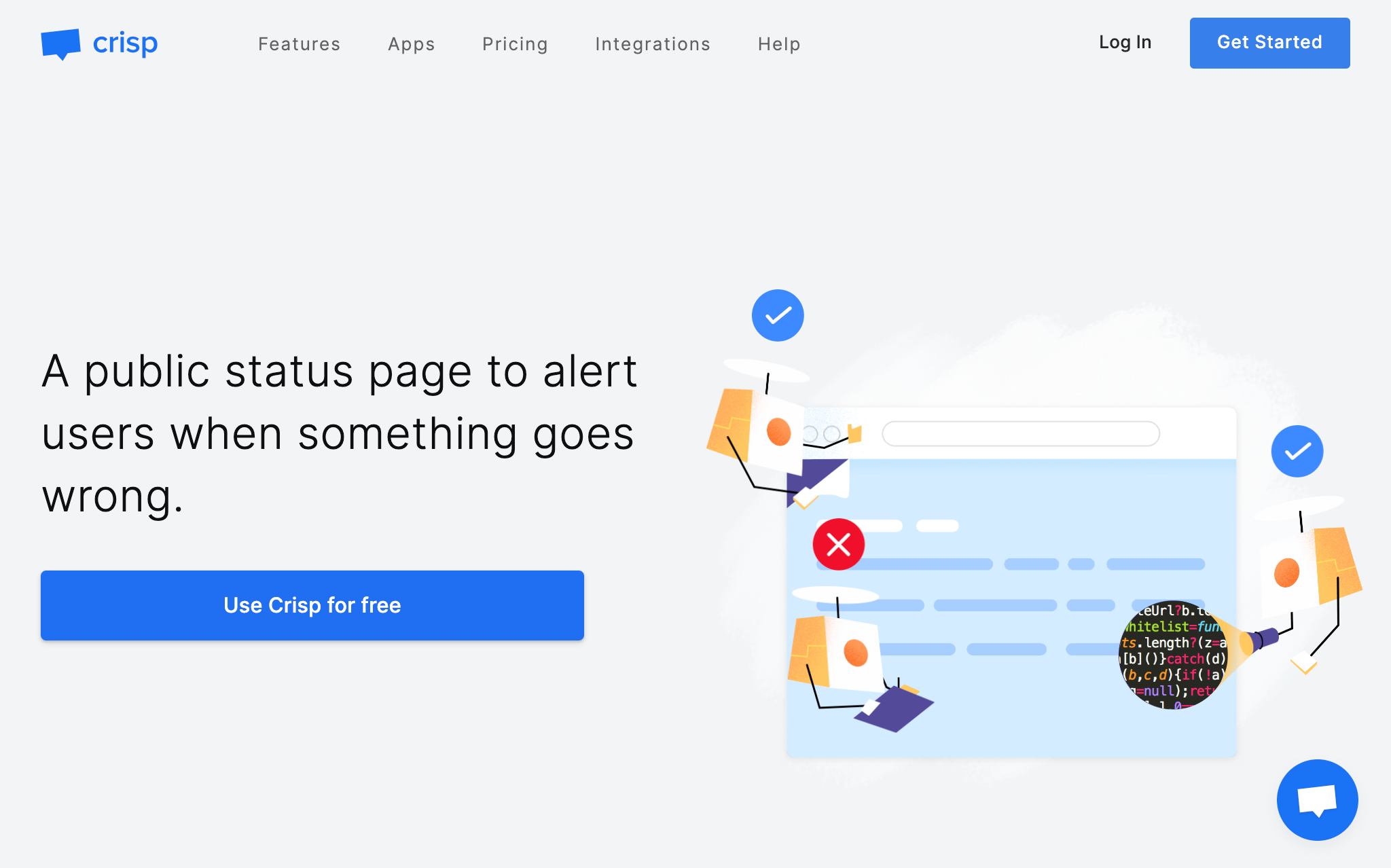
Crisp offers public status pages with free subscriptions. They emphasize the fact that their public status page can integrate with various other customer support tools, such as Slack, Hubspot, and Messenger. Admins can customize their choice of support tools too. This integration capability adds flexibility to your preferred communication choices.
Despite only offering a public status age, over 500,000 brands use Crisp to improve communication and transparency amongst their customer base. To see if Crisp would be a beneficial feature to your service or business, check them out with a free 14-day trial.
Clients: Mailjet, Rakuten, AirFrance.
Conclusion
As we can see top SaaS companies rely on Statuspage.io as the most popular status page provider in 2024. But clearly, there are great options for public status pages to choose from and our overview of Statuspage alternatives is here to help.
As for the private status page, StatusGator is perfectly equipped to meet the needs of internal IT teams working in various spheres. StatusGator gives your team a unified status page showing the status of all of your cloud vendors, hosted applications, services, websites, affiliate marketing apps, and more.
Try StatusGator for free today – it only takes a few minutes to start.

FAQ on the Most Popular Status Page Providers
Q: What is the most popular status page service?
A: Statuspage.io remains the most popular status page service in 2024. However, status pages by Statuspal and the Sorry app are popular too. With numerous features to offer, including unique features, like status page aggregation by StatusGator, there are plenty of decent Statuspage alternatives available.
Q: What is the best practice for a status page?
A: Best practices for a status page include transparency, timely updates, clear communication, display of historical data, subscription options, maintenance notices, and more. To learn more about status page best practices, check out StatusGator, which offers a unified status page. You can also review some examples of good status pages.
Q: Is Statuspage free?
A: No, Statuspage is not free. However, there’s a free plan on a basic public status page. Some argue that Statuspage.io is one of the most expensive tools out there, but it remains popular. However, cheaper alternatives offer unique services that are not available with Statuspage. For example, StatusGator offers insight into the statuses of 3K third-party companies that can be aggregated into a unified status page. So users can monitor not only their own website or service but also all their dependencies.
Q: How do I create a status page?
A: Creating a status page typically involves choosing a platform, like StatusGator, Statuspage, or Cachet, configuring, customizing, testing, and launching. Cachet is a self-hosted status page, and typically it takes longer to create a status page with self-hosted services. With StatusGator, you will have your status page running in a few minutes, where you can display not only the status of your services but also the statuses of the cloud providers you depend on.
Q: What is Atlassian Statuspage?
A: Atlassian Statuspage is a status page provider for communicating applications’ or services’ status to users in real time. Statuspage is the most popular status page provider in 2024, however, there are some great alternative status page services such as StatusGator, Status.io, Statuscast, Sorry app, and others.
Recent Posts

